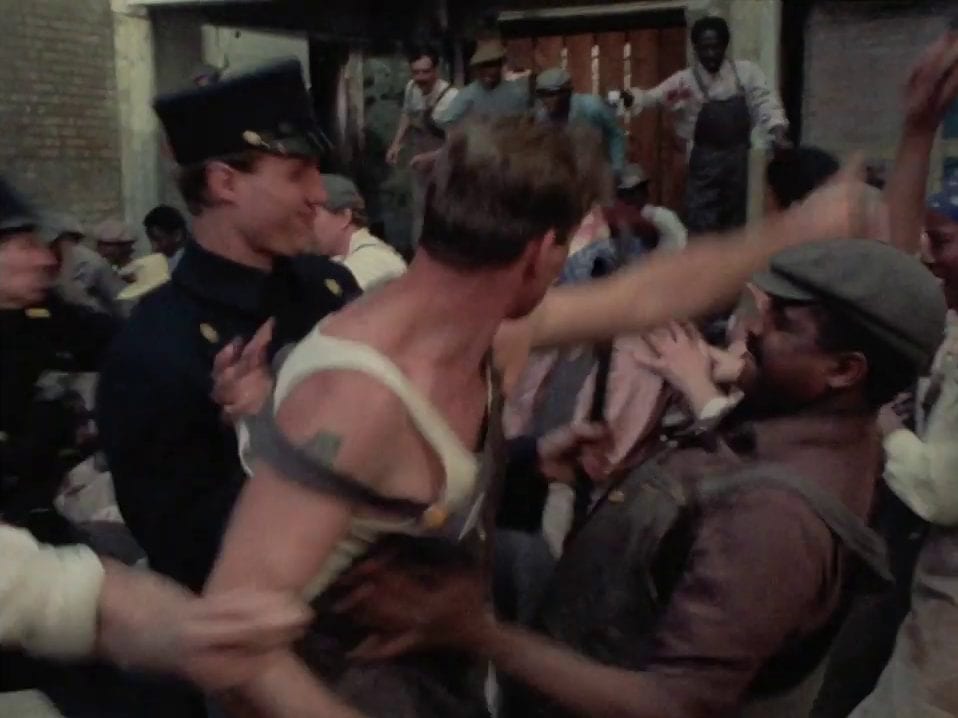
Film Review: The Killing Floor
Directed by Bill Duke. US, 1984, 118 minutes.
Available on June 19 at the “Virtual Cinema” pages of the Brattle Theatre, the Cabot Street Cinema, and other film institutions.
First thing you hear in The Killing Floor is voiceover narration delivered by a black man in the South circa September 1917, right before he catches a train for Chicago. “The war came and all of a sudden there were jobs up North,” he says—a line so evocative and precise that I wrongly assumed the movie had been adapted from a text of the ’20s or ’30s. But The Killing Floor was actually produced from an original script, and one that had a whole team behind it: The story is credited to executive producer Elsa Rassbach, the “adaptation” to Ron Milner, and the screenplay itself to playwright Leslie Lee, plus the end credits list about 15 additional researchers who pitched in at one point or another.
One can’t often say this of a narrative movie that’s made in the USA, but The Killing Floor puts all their work right there on the screen. Directed by the great actor and longtime journeyman filmmaker Bill Duke, the film stages personalized experiences of the Great Migration, the return of soldiers from the Great War, the racial dynamics in Chicago leading up to the white riots of 1919, and most of all the labor conditions of the city’s meatpacking industry around the same time—about 15 years after that labor scene had been recorded into history from a much different perspective by The Jungle.
Lee’s screenplay weaves those histories together by charting their cascading effects on a years-long unionization effort by the stockyard workers. Emphatically attuned to process and place, The Killing Floor depicts the drive as an unending quest to achieve minor and perhaps even unjustified shifts in the worker’s individual belief structures—with pro- and anti-union forces depicted as being in constant debate via dialogue scenes that quite realistically cross from the workfloor to the locker room and then to barrooms or dinner tables before finally starting anew the next day (the most oft-cited pull quote regarding the film is a Village Voice line dubbing it the “[most] clear-eyed account of union organizing on film,” which if anything just reminds us how rarely that subject is depicted within the commercial American cinema—though one recent film to do so is High Flying Bird, 2018, directed by Steven Soderbergh and featuring a pivotal and basically deified character played by Bill Duke).
The extensive background research guiding Lee’s script is realized not only in the film’s depiction of the unionization process, but also in the language employed by the characters, as well as in the archival footage used as interstitials between scenes. And the function of those qualities adds up to far more than just period detail and regional texture: The film’s relationship to established facts and records are what drives its narrative momentum—and what eventually grants it true purpose. The Killing Floor reveals itself to be an intrinsically American historical epic.
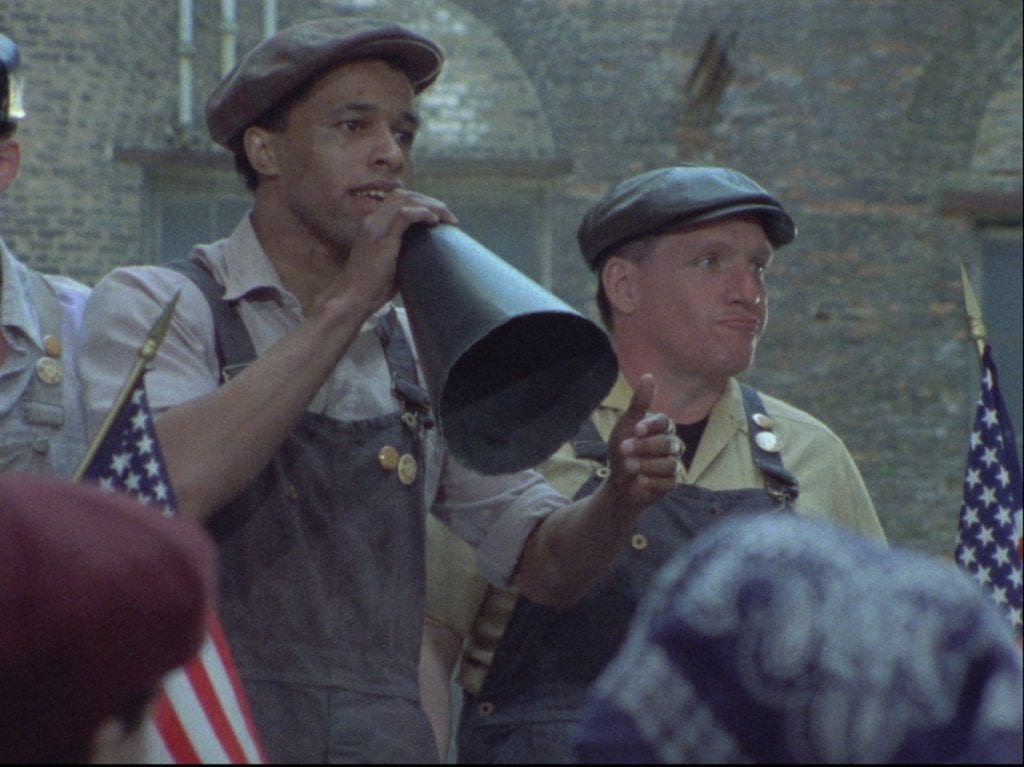
In an interview with Time Out last year, Rassbach detailed the research that prompted the project:
I had been hired at the public television station in Boston, WGBH, to work on the first seasons of Nova (1974-), and I received support from the National Endowment for the Humanities to develop a public television series on the history of the American labor movement. In William Tuttle’s book [Race Riot: Chicago in the Red Summer of 1919, 1970] I happened upon a footnote in which I discovered the two main characters in The Killing Floor: Frank Custer and Heavy Williams. These two black men, who both worked on the killing floor of a Chicago slaughterhouse, were testifying before a white federal judge, and the two were entirely at odds with each other in how they viewed the causes of the mounting racism from which they were both suffering. … I ordered from the National Archives the entire transcript of the hearing in which the two testified. All of the characters who work on “the killing floor” in our film, both black and white, leapt out of the thousands of pages of testimony by a group of workers at the Wilson Meatpacking Company in June of 1919.
Frank Custer (Damien Leake), the narrator who says that opening line, is positioned as the protagonist. Upon his arrival in Chicago he takes a job mopping the floors of a slaughterhouse and becomes determined to work his way up to butcher—something the mostly white union organizers at the plant quickly ascertain, and just as quickly utilize to their own advantage. With promises of advancement and better pay, they slowly but purposefully shape Custer into something like the unofficial delegate of the stockyard’s black union workers, a position he takes on with great passion. As for Williams (Moses Gunn), though he constantly ribs and occasionally even assaults Custer, he’s less antagonist than he is the younger man’s shadow. He believes and indeed acts on the very doubts and fears that Custer has to push away in his role as an organizer—primarily that the white union leaders are only encouraging solidarity with the black workers for their own good, an exceptionally justified position backed up even further by events that occur during the course of the riots.
As in most stories about duality, Custer and Williams don’t oppose each other so much as they infect one another. So a film that at first seems to be a “social justice drama” or perhaps even pro-union agitprop instead becomes highly specific to character, performance, and the opposing convictions they represent—The Killing Floor is rousingly dialectic. Custer’s position in the union is not rewarded but tested from every angle, with each incident cracking the foundation of his faith. And Williams’ hard-ass persona, as well as his hard-earned and bitterly held black-individualist philosophy, is not critiqued so much as it’s sympathized with, understood, poeticized, and perhaps even argued for.
And the direction articulates these conflicts not just in dialogue but also in the gestures and staging of the actors, which keeps this ostensibly political film very physical and tangible at every moment: One will not easily forget the moment where Gunn’s Williams, framed in a long shot while Custer speaks to the right of him, quickly processes an upsetting statement while simultaneously crafting his comeback. For a brief moment each side of the film’s ideological divide is worn plainly on his face.
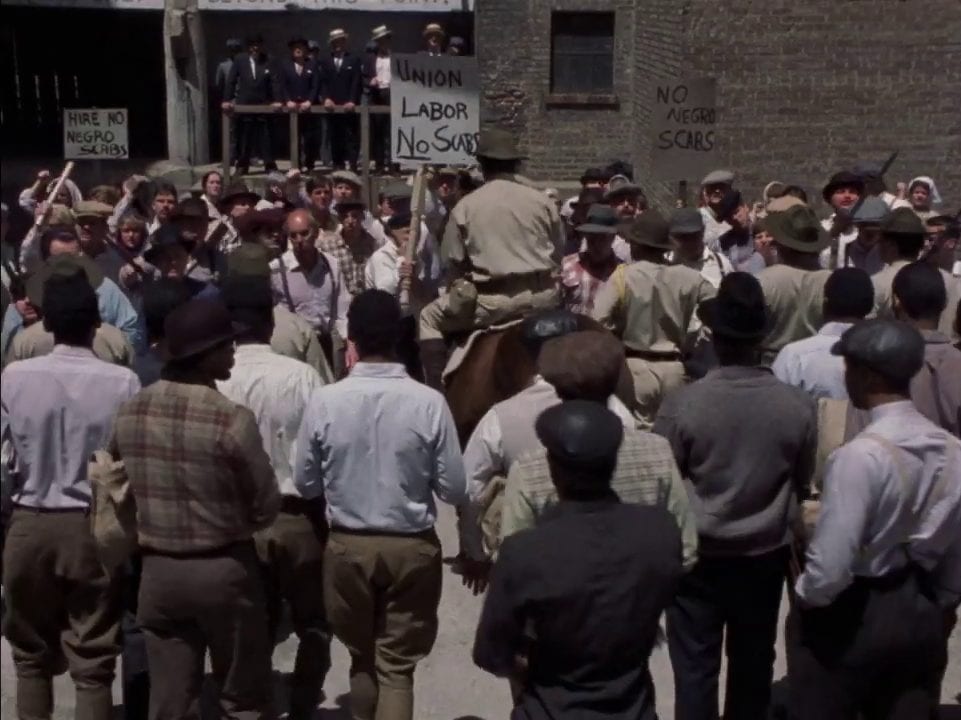
Of course the nature of American television censorship means that while Duke’s film cannot realistically depict workplace injuries, violence, or sexual relations of any kind, it is nonetheless able to depict utterly grotesque racism and hate speech without much redaction. Slurs are levied here not only in dialogue but also in graffito, protest signs, and by various other manners of public display. And in all that The Killing Floor presents a stark and unsensationalized depiction of American racism during the period in question—a characteristic made even more notable because it also declines to represent “whiteness” as anything more than a malicious bogeyman lingering just offscreen: That “identity,” while not yet attached to the Polish immigrants working alongside black Americans in the film’s stockyard circa 1917, had by then been granted to the city’s Irish population, who are represented in Duke’s images by old ladies and teenagers menacing from stoops and street corners… and later on when some of the archival newsreel footage depicts the burning and destruction of homes in the Back of the Yards neighborhood, at that point mostly populated by Lithuanian and Polish emigres, Custer’s narration attributes the crime to “white men in blackface”—alluding to contemporary accounts that credit the arson to a specific Irish gang.
Though its margins are sketched full with side characters and incidents, at the center of The Killing Floor is a specific conflict that courses through all the other drama: a choice facing Custer between “labor solidarity” with the Polish workers on the one hand, and the solidarity of black American people against systems that seek to exploit them on the other. A key scene, and in retrospect probably the most affecting, happens when Custer and his wife Mattie (Alfre Woodard) have dinner with a number of white labor organizers and their respective wives. The established organizers hint around a certain point—that they’re quite pleased to have a high-ranking black member among them specifically because they’re counting on Custer to curtail the use of non-unionized black laborers during future strikes. Custer smiles through it, but the blatant acknowledgement of his borderline token status is just one more crack in his union button. And it leads him indirectly to the film’s conclusion, a physical stand-off with genuinely philosophical underpinnings: The Killing Floor is presented as if it’s making an argument, but Duke’s grand accomplishment is that by the end credits you don’t know exactly what it was agitating for.
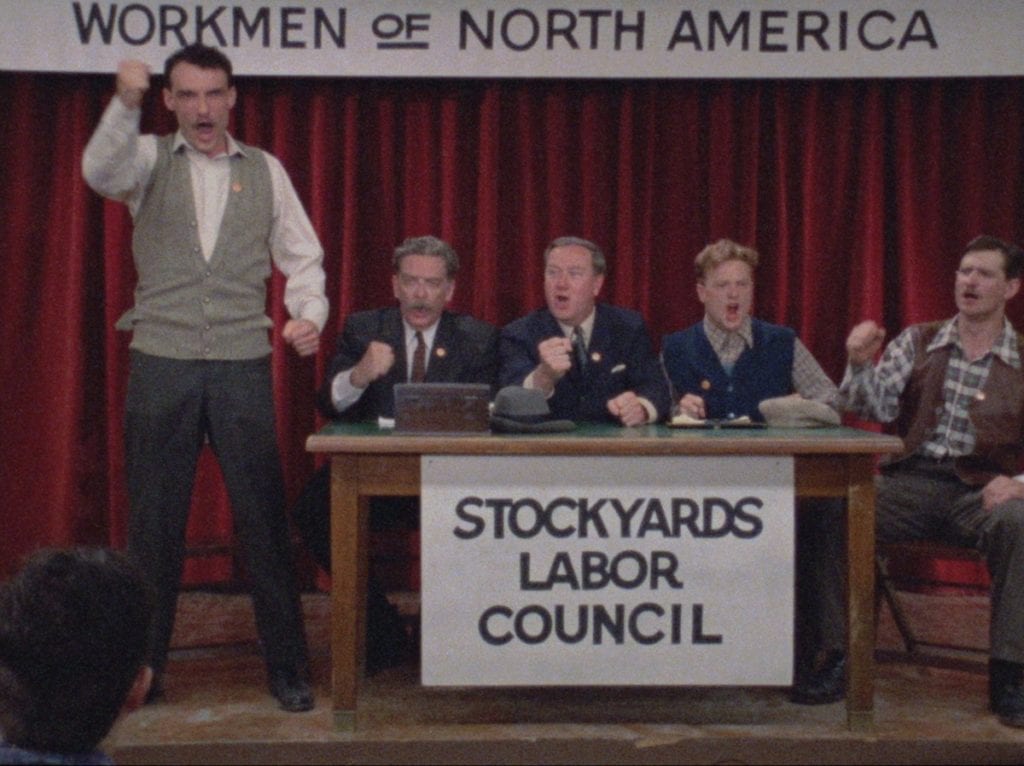
The film’s road to production is a story of its own, almost equally rich with implication. Rassbach envisioned Duke’s film as the first entry in a 10-part program dramatizing the history of labor organizing and relations in the United States. The series was to be called “Made in USA” and was meant to be aired under the banner of PBS’s American Playhouse (1982-96), which is where The Killing Floor premiered in 1984 before playing at festivals including Sundance and Cannes. And the most thorough account of its decades-long financing woes is courtesy the Aug 1, 1990 issue of Fairness & Accuracy In Reporting, which featured a piece quite pointedly headlined “No Place for Labor on PBS?”
According to the FAIR report, PBS first dictated that only a minuscule percentage of the series’ budget could be raised from “labor contributions”—basically a death knell for a project that was decidedly against corporate interests. “Faced with criticism, PBS loosened its restrictions,” and so The Killing Floor was financed piecemeal by small investments from numerous labor organizations, among other contributions. But despite that concession the film’s union shoot in Chicago was still only feasible because all crewmembers deferred huge portions of their salaries, a fact borne out by the “special thanks” during the end titles: The credits for union groups takes up twice as much time as the cast list, proceeding alphabetically from the Amalgamated Clothing & Textile Workers Union down to the United Rubber, Cork, Linoleum & Plastic Workers of America.
Details on some of the unmade projects in the “Made in USA” series can also be found in the FAIR piece, as well as in various press releases distributed throughout the ’90s, and even in the Lowell Sun, which in August 1992 reported the following about what Rassbach hoped would be the second film in the series: “Lost Eden, set in the 1840s, is based on the true story of young women textile workers, the mill girls, who led a fledgling labor movement and fought censorship in their literary magazine,” per the report, which did not mention a prospective director. “The project has been in the planning and funding stages for more than six years, but was delayed until the looms in the Boott Cotton Mills Museum were operational. Funding problems also thwarted [prior efforts at producing the film], which is budgeted at $1.5 million.” The film never materialized, nor did the planned third entry in the series, Homestead, which a October 1996 press release described as being “about the infamous 1892 strike/lockout in Andrew Carnegie’s Pennsylvania steel mill.”
As for why the second film was never produced, the FAIR report offers a theory that I see no reason not to reproduce: “Initially, [Lost Eden] was promised $400,000 from American Playhouse, which has become PBS’s only source of funding for fiction programs,” the article noted. “But American Playhouse pulled out, saying the script was ‘too melodramatic.’ Perhaps coincidentally, the chair of Boston’s WGBH, the parent station of American Playhouse, is James Lowell, the heir of the textile concern involved in the story.”
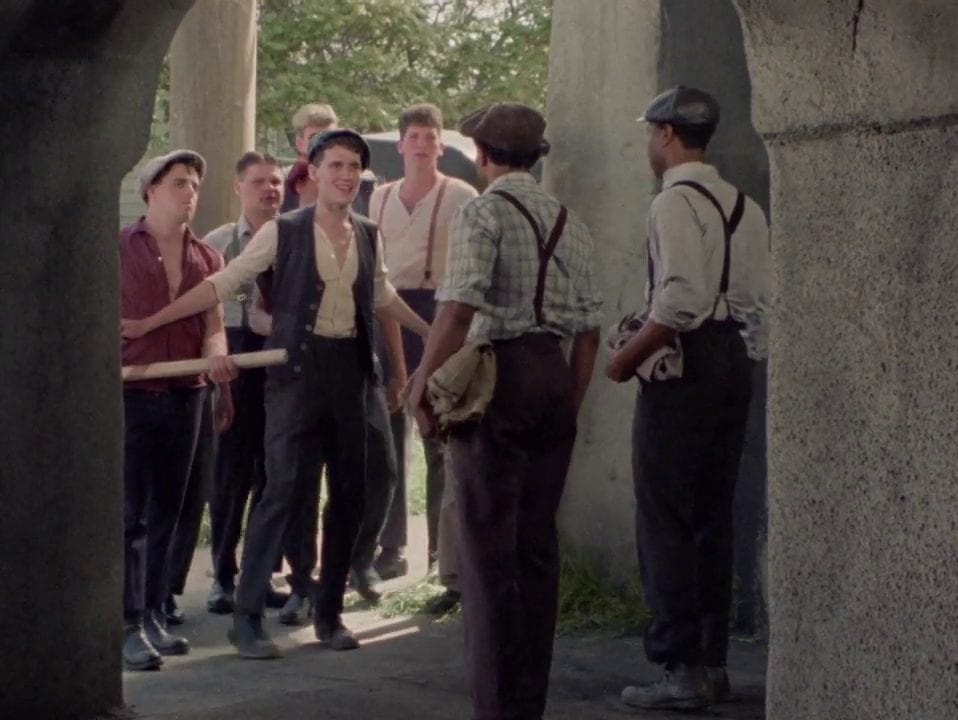
Despite having already made too many comments about the credit sequences of The Killing Floor, I’ll conclude with a couple more. Duke’s composition of the dramatic scenes for the most part utilizes the standard visual syntax of television drama, but many of the film’s other formal choices are quite daring—specifically the use of newsreel footage, and most of all two incredibly atypical uses of onscreen text.
The first is the opening title card, which comes up in the middle of some narration from Custer. He’s speaking hopefully about the journey to Chicago, and the plainly foreboding title comes in over an image of the train as if to undercut what he’s saying. But incredibly, given the circumstances, neither the narration nor the film’s title seem an ironic comment on the other—instead they just coexist, like the many other irreconcilable perspectives the film allows its characters to stake out.
And the second one happens at the end, when the film describes what eventually happened to the historical personages depicted therein. That text-based passage reports a detail that reorients the movie in yet another new context, one that brings things back to where it all began—the archive. The very last sentence of the film, it not only points to all the work left to be done but also despairingly acknowledges the immeasurable amount of knowledge and records already irretrievably forgotten. And though contradictory it may seem, in all these unresolved conflicts and blank spaces The Killing Floor’s image of history becomes thrillingly whole. [★★★★]

